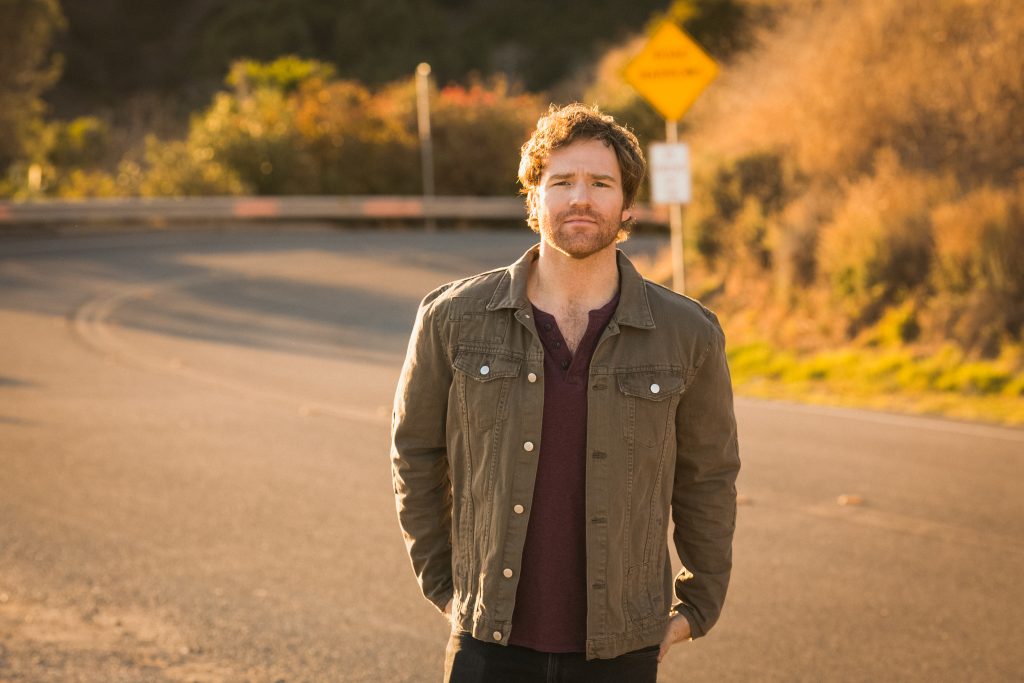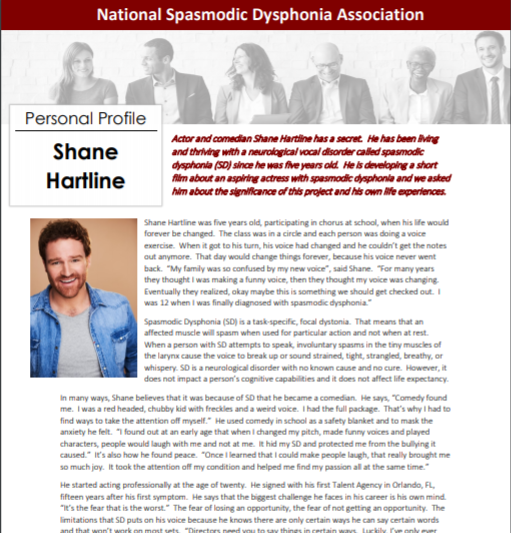Profile-Shane Hartline…How his experience with SD inspires a new short film
March, 2019

Shane Hartline was five years old, participating in chorus at school, when his life would forever be changed. The class was in a circle and each person was doing a voice exercise. When it got to his turn, his voice had changed and he couldn’t get the notes out anymore. That day would change things forever, because his voice never went back. “My family was so confused by my new voice”, said Shane. “For many years they thought I was making a funny voice, then they thought my voice was changing. Eventually they realized, okay maybe this is something we should get checked out. I was 12 when I was finally diagnosed with spasmodic dysphonia.”
Spasmodic Dysphonia (SD) is a task-specific, focal dystonia. That means that an affected muscle will spasm when used for particular action and not when at rest. When a person with SD attempts to speak, involuntary spasms in the tiny muscles of the larynx cause the voice to break up or sound strained, tight, strangled, breathy, or whispery. SD is a neurological disorder with no known cause and no cure. However, it does not impact a person’s cognitive capabilities and it does not affect life expectancy.
SD and comedy
In many ways, Shane believes that it was because of SD that he became a comedian. He says, “Comedy found me. I was a red headed, chubby kid with freckles and a weird voice. I had the full package. That’s why I had to find ways to take the attention off myself.” He used comedy in school as a safety blanket and to mask the anxiety he felt. “I found out at an early age that when I changed my pitch, made funny voices and played characters, people would laugh with me and not at me. It hid my SD and protected me from the bullying it caused.” It’s also how he found peace. “Once I learned that I could make people laugh, that really brought me so much joy. It took the attention off my condition and helped me find my passion all at the same time.”
He started acting professionally at the age of twenty. He signed with his first Talent Agency in Orlando, FL, fifteen years after his first symptom. He says that the biggest challenge he faces in his career is his own mind. “It’s the fear that is the worst.” The fear of losing an opportunity, the fear of not getting an opportunity. The limitations that SD puts on his voice because he knows there are only certain ways he can say certain words and that won’t work on most sets. “Directors need you to say things in certain ways. Luckily, I’ve only ever been in a situation where my voice did not cooperate twice and on very small projects. But those situations still created a paranoia in my head. It’s something I’ve struggled with, continue to struggle with, but work on every day.”
Going public about his voice disorder
In addition, Shane has never disclosed his vocal disorder. “When I audition for a project and read the lines, the casting director sees me and hears me. Once I get the job and I am on set and if they are like, what’s wrong with you? I think, you saw me, you heard me, you chose me. I really don’t care anymore.”
In fact, this article and coming forward to the SD community will be the first time he’s ever gone public about his condition. “I have always had a fear of going public because of my passion and profession.” However, he had a story he felt compelled to tell and wanted to share it with the community. Shane’s newest project is a short film called “Cookie”, about a woman who is an aspiring actress living with SD.
Writing a story to increase awareness
“It may sound cliché or cheesy but I really needed to write this story. I needed to get it out of my system, I needed to try to help people. I’ve spent so many years telling myself, when I make it, I am going to help other people with SD. Well I’m tired of waiting and I decided to just do what I can right now. And that’s make the best movie possible to raise as much awareness as possible for SD.”
“As I was writing about my story and my struggle, I decided I wanted to represent everyone else’s struggles through one voice. That’s the main character, Gaby. Ideally, I want to cast someone that actually has it and truly suffers from the condition. SD does not impact a person’s cognitive ability. So, while Gaby is thinking thousands of thoughts in a perfect voice, when she speaks, only a few broken words come out.”
“I believe capturing the pain and struggle on camera is the only way to affect the viewer on that deep level that is needed to get our message across. The way I have written it is not in a way to educate or teach the viewer anything, it’s to make them feel what SD sufferers feel on a daily basis. That’s so important to me.”
Shane becomes a part of the NSDA community
He took a leap and jumped into the SD Facebook Community first to talk about it. Then he contacted the National Spasmodic Dysphonia Association (NSDA). “For many years I just thought of the NSDA as this organization that was just pushing Botox® on people,” said Shane. (Botox® is a primary treatment option to alleviate SD symptoms.) “But after diving into the private SD community, researching the NSDA and all that they do for the people with the condition, and speaking to some of their people directly, my opinion of them has completely changed. I think they are doing such great things and truly strive to bring awareness to the condition.”
The SD community is comprised not only of the NSDA, but also the healthcare providers who treat those with SD and most importantly, those living with the disorder, who share information and support each other. In fact, the NSDA sponsors more than 50 support groups throughout the United States so that people with SD and related voice conditions know that they are not alone in their struggles and can compare what has worked for them.
While he never attended a local support group meeting, Shane has experimented with all different types of treatments. He has done acupuncture, hypnotherapy, regression therapy (which he says was pretty wild), and speech therapy. He has also experimented with Botox®, vocal exercises, mental exercises, vitamins, medications, essential oils and anything else that he hears about. “If you can think of it, I’ve probably experimented with it”, say Shane. “It’s hard to pinpoint what has helped me get to the very mild state of the condition that I’ve been able to get to. What I truly believe is that with spasmodic dysphonia being a neurological condition, things can only help so much.”
Struggles with SD
“Those who have SD probably know that when they’ve had a few drinks or are feeling very confident, the SD symptoms can be reduced. So I asked myself, how can I achieve that all the time?
For me it’s putting my mind in a place of confidence, doing more and more things that scare me and growing my confidence even more, that’s when my voice is best. That’s also all I have control over.”
His “Cookie” project has really helped him as well. As Shane says, “it’s opened doors within myself. I’m not caring as much about my SD or what I think it may prevent me from doing. I only have this one life and I have to tell this story and hopefully help people in the process. By being an advocate for those with SD, I’m feeling even more confident.”
But he still experiences the normal struggles of living with SD. “I’ve had an audition where my voice held me back from reaching my fullest potential. I’ve had bad interactions with others as a result of my voice. People ask me if I am sick. It’s pretty difficult making phone calls. But the hardest thing about living with SD is how much I want to talk to strangers, talk on the phone, just plain talk, but I hold myself back because it’s easier not to.” He’s even dealt with bouts of depression, but credits his amazing family for support in those hard times. “I know I’m so lucky to have a very mild case of SD, but it’s still there. I ask myself ‘why me’? I know everyone has their thing, and I just have to work every day to find peace with my thing.”
Without his family he doesn’t think he could have gotten to where he is today. “They are my rock and emotional support system. My mother specifically; she’s the most amazing human being I’ve ever met and I’m so lucky to have her.” His family is very understanding and patient with his condition. They help him when he wants to try a new treatment he’s discovered, and they just give him an ear when he needs one.
Acting with a voice disorder
We asked Shane what he would say if someone thought he was crazy for going into acting with a voice disorder. “Maybe years ago someone else’s opinion of me would have bothered me, but it literally has no effect on me now.
I’ve been able to do some really awesome things in this business, probably more than some without a voice condition, and I want to use that to motivate people in a similar position. I say, screw what other people think!”
He has also discovered that in pursuing his dream with SD has really motivated a lot of people. Before this, people thought of Shane is just another guy wanting to be an actor. “What I hope now is that they look at me and say, ‘Shane’s a guy with a VOICE condition who IS an actor… what’s stopping me from going for it?’ Don’t get me wrong, I’d love some kind of pill that would miraculously fix it, but until that happens I have to do whatever brings me peace. All these years I’ve kept quiet about it, but it’s this voice that is helping others. Being able to motivate others to pursue their dream, that is so amazing to me.”
SD is a lifelong journey for Shane, but he hopes that in the next 10 years he will direct, produce, and act in all kinds of genres of films.
As for the new short film Cookie, visit the website www.CookieShortFilm.com starting on World Voice Day, April 16th, to find out more information on the short and its campaign launching soon. Shane will be giving 5% of the campaign’s proceeds to the National Spasmodic Dysphonia Association and taking no compensation from the Cookie project.



